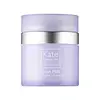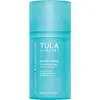What's inside
What's inside
 Key Ingredients
Key Ingredients

 Benefits
Benefits

 Concerns
Concerns

 Ingredients Side-by-side
Ingredients Side-by-side

Water
Skin ConditioningEthylhexyl Palmitate
EmollientMyristyl Myristate
EmollientGlyceryl Stearate
EmollientPEG-100 Stearate
Cetearyl Ethylhexanoate
EmollientDecyl Oleate
EmollientGlycerin
HumectantPropanediol
SolventGoat Milk
Skin ConditioningLactose
HumectantMilk Protein
Skin ConditioningHelianthus Annuus Seed Oil
EmollientHamamelis Virginiana Flower Water
AstringentCocos Nucifera Oil
MaskingPersea Gratissima Oil
Skin ConditioningSimmondsia Chinensis Seed Oil
EmollientVitis Vinifera Seed Oil
EmollientAloe Barbadensis Leaf Juice Powder
Skin ConditioningOryza Sativa Bran Extract
Skin ConditioningRosmarinus Officinalis Leaf Extract
AntimicrobialTocopheryl Acetate
AntioxidantTocopherol
AntioxidantCaprylyl Glycol
EmollientAcrylates/C10-30 Alkyl Acrylate Crosspolymer
Emulsion StabilisingPhenoxyethanol
PreservativeEthylhexylglycerin
Skin ConditioningHexylene Glycol
EmulsifyingXanthan Gum
EmulsifyingAminomethyl Propanol
BufferingDisodium EDTA
Lactic Acid
BufferingBenzoic Acid
MaskingWater, Ethylhexyl Palmitate, Myristyl Myristate, Glyceryl Stearate, PEG-100 Stearate, Cetearyl Ethylhexanoate, Decyl Oleate, Glycerin, Propanediol, Goat Milk, Lactose, Milk Protein, Helianthus Annuus Seed Oil, Hamamelis Virginiana Flower Water, Cocos Nucifera Oil, Persea Gratissima Oil, Simmondsia Chinensis Seed Oil, Vitis Vinifera Seed Oil, Aloe Barbadensis Leaf Juice Powder, Oryza Sativa Bran Extract, Rosmarinus Officinalis Leaf Extract, Tocopheryl Acetate, Tocopherol, Caprylyl Glycol, Acrylates/C10-30 Alkyl Acrylate Crosspolymer, Phenoxyethanol, Ethylhexylglycerin, Hexylene Glycol, Xanthan Gum, Aminomethyl Propanol, Disodium EDTA, Lactic Acid, Benzoic Acid
Water
Skin ConditioningSqualane
EmollientCaprylic/Capric Triglyceride
MaskingGlycerin
HumectantLactococcus Ferment Lysate
Skin ConditioningIsoamyl Laurate
EmollientCetearyl Olivate
Butyrospermum Parkii Butter
Skin ConditioningPseudozyma Epicola/Argania Spinosa Kernel Oil/Olive Fruit Oil/Sunflower Seed Oil/(Angelica Gigas/Licorice/Lithospermum Erythrorhizon) Root Ferment Extract Filtrate
EmollientSorbitan Olivate
EmulsifyingLycium Barbarum Fruit Extract
AstringentCopper Palmitoyl Heptapeptide-14
Skin ConditioningHeptapeptide-15 Palmitate
Skin ConditioningHoney
HumectantPhospholipids
Skin ConditioningBetaine
HumectantNiacinamide
SmoothingSodium Phytate
Sorbitol
HumectantGluconolactone
Skin ConditioningLactic Acid
BufferingPhosphatidylcholine
EmulsifyingSesamum Indicum Seed Extract
Skin ConditioningTremella Fuciformis Sporocarp Extract
AntioxidantDehydroacetic Acid
PreservativeDocosahexaenoic Acid
Skin ConditioningSphingolipids
EmollientXanthan Gum
EmulsifyingPinus Pinaster Bark Extract
AntioxidantSodium Acetylated Hyaluronate
HumectantSodium Hyaluronate
HumectantHyaluronic Acid
HumectantEicosapentaenoic Acid
EmollientLactic Acid/Glycolic Acid Copolymer
Skin ConditioningCaprylyl Glycol
EmollientSodium Hyaluronate Crosspolymer
HumectantTocopherol
AntioxidantTetrasodium Glutamate Diacetate
Tocopheryl Acetate
AntioxidantHydrolyzed Sodium Hyaluronate
Skin ConditioningCalcium Gluconate
HumectantGlyceryl Caprylate
EmollientPolyvinyl Alcohol
Phenylpropanol
MaskingPhytosphingosine
Skin ConditioningCurcuma Longa Root Extract
MaskingDimethylmethoxy Chromanol
AntioxidantAscorbyl Palmitate
AntioxidantLecithin
EmollientHydrogenated Palm Glycerides
EmollientPhenoxyethanol
PreservativeTetrahexyldecyl Ascorbate
AntioxidantPotassium Sorbate
PreservativeCarbomer
Emulsion StabilisingCetyl Palmitate
EmollientPropanediol
SolventSodium Chloride
MaskingDimethyl Isosorbide
SolventSorbitan Palmitate
EmulsifyingCetyl Alcohol
EmollientPentylene Glycol
Skin ConditioningSodium Hydroxide
BufferingSodium Benzoate
MaskingEthylhexylglycerin
Skin ConditioningWater, Squalane, Caprylic/Capric Triglyceride, Glycerin, Lactococcus Ferment Lysate, Isoamyl Laurate, Cetearyl Olivate, Butyrospermum Parkii Butter, Pseudozyma Epicola/Argania Spinosa Kernel Oil/Olive Fruit Oil/Sunflower Seed Oil/(Angelica Gigas/Licorice/Lithospermum Erythrorhizon) Root Ferment Extract Filtrate, Sorbitan Olivate, Lycium Barbarum Fruit Extract, Copper Palmitoyl Heptapeptide-14, Heptapeptide-15 Palmitate, Honey, Phospholipids, Betaine, Niacinamide, Sodium Phytate, Sorbitol, Gluconolactone, Lactic Acid, Phosphatidylcholine, Sesamum Indicum Seed Extract, Tremella Fuciformis Sporocarp Extract, Dehydroacetic Acid, Docosahexaenoic Acid, Sphingolipids, Xanthan Gum, Pinus Pinaster Bark Extract, Sodium Acetylated Hyaluronate, Sodium Hyaluronate, Hyaluronic Acid, Eicosapentaenoic Acid, Lactic Acid/Glycolic Acid Copolymer, Caprylyl Glycol, Sodium Hyaluronate Crosspolymer, Tocopherol, Tetrasodium Glutamate Diacetate, Tocopheryl Acetate, Hydrolyzed Sodium Hyaluronate, Calcium Gluconate, Glyceryl Caprylate, Polyvinyl Alcohol, Phenylpropanol, Phytosphingosine, Curcuma Longa Root Extract, Dimethylmethoxy Chromanol, Ascorbyl Palmitate, Lecithin, Hydrogenated Palm Glycerides, Phenoxyethanol, Tetrahexyldecyl Ascorbate, Potassium Sorbate, Carbomer, Cetyl Palmitate, Propanediol, Sodium Chloride, Dimethyl Isosorbide, Sorbitan Palmitate, Cetyl Alcohol, Pentylene Glycol, Sodium Hydroxide, Sodium Benzoate, Ethylhexylglycerin
 Reviews
Reviews

Ingredients Explained
These ingredients are found in both products.
Ingredients higher up in an ingredient list are typically present in a larger amount.
Caprylyl Glycol is a humectant and emollient, meaning it attracts and preserves moisture.
It is a common ingredient in many products, especially those designed to hydrate skin. The primary benefits are retaining moisture, skin softening, and promoting a healthy skin barrier.
Though Caprylyl Glycol is an alcohol derived from fatty acids, it is not the kind that can dry out skin.
This ingredient is also used as a preservative to extend the life of products. It has slight antimicrobial properties.
Learn more about Caprylyl GlycolEthylhexylglycerin (we can't pronounce this either) is commonly used as a preservative and skin softener. It is derived from glyceryl.
You might see Ethylhexylglycerin often paired with other preservatives such as phenoxyethanol. Ethylhexylglycerin has been found to increase the effectiveness of these other preservatives.
Glycerin is already naturally found in your skin. It helps moisturize and protect your skin.
A study from 2016 found glycerin to be more effective as a humectant than AHAs and hyaluronic acid.
As a humectant, it helps the skin stay hydrated by pulling moisture to your skin. The low molecular weight of glycerin allows it to pull moisture into the deeper layers of your skin.
Hydrated skin improves your skin barrier; Your skin barrier helps protect against irritants and bacteria.
Glycerin has also been found to have antimicrobial and antiviral properties. Due to these properties, glycerin is often used in wound and burn treatments.
In cosmetics, glycerin is usually derived from plants such as soybean or palm. However, it can also be sourced from animals, such as tallow or animal fat.
This ingredient is organic, colorless, odorless, and non-toxic.
Glycerin is the name for this ingredient in American English. British English uses Glycerol/Glycerine.
Learn more about GlycerinLactic Acid is another well-loved alpha hydroxy acid (AHA). It is gentler than glycolic acid but still highly effective.
Its main role is to exfoliate the surface of the skin by loosening the “glue” that holds dead skin cells together. Shedding those old cells leads to smoother, softer, and more even-toned skin.
Because lactic acid molecules are larger than glycolic acid, they don’t penetrate as deeply. This means they’re less likely to sting or irritate, making it a great choice for beginners or those with sensitive skin.
Like glycolic acid, it can:
Lactic acid also acts as a humectant (like hyaluronic acid). It can draw water into the skin to improve hydration and also plays a role in the skin's natural moisturizing factor (NMF) in the form of sodium lactate.
Studies show it can boost ceramide production to strengthen the skin barrier and even help balance the skin’s microbiome.
To get results, choose products with a pH between 3-4.
Lower strengths (5-12%) focus on surface exfoliation; higher strengths (12% and up) can reach deeper in the dermis (deeper, supportive layer) to improve skin texture and firmness over time.
Though it was originally derived from milk, most modern lactic acid used in skincare is vegan. It is made through non-dairy fermentation to create a bio-identical and stable form suitable for all formulations.
When lactic acid shows up near the end of an ingredient list, it usually means the brand added just a tiny amount to adjust the product’s pH.
Legend has it that Cleopatra used to bathe in sour milk to help reduce wrinkles.
Lactic acid is truly a gentle multitasker: it exfoliates, hydrates, strengthens, and brightens. It's a great ingredient for giving your skin a smooth, glowing, and healthy look without the harshness of stronger acids.
Read more about some other popular AHA's here:
Learn more about Lactic AcidPhenoxyethanol is a preservative that has germicide, antimicrobial, and aromatic properties. Studies show that phenoxyethanol can prevent microbial growth. By itself, it has a scent that is similar to that of a rose.
It's often used in formulations along with Caprylyl Glycol to preserve the shelf life of products.
Propanediol is an all-star ingredient. It softens, hydrates, and smooths the skin.
It’s often used to:
Propanediol is not likely to cause sensitivity and considered safe to use. It is derived from corn or petroleum with a clear color and no scent.
Learn more about PropanediolTocopherol (also known as Vitamin E) is a common antioxidant used to help protect the skin from free-radicals and strengthen the skin barrier. It's also fat soluble - this means our skin is great at absorbing it.
Vitamin E also helps keep your natural skin lipids healthy. Your lipid skin barrier naturally consists of lipids, ceramides, and fatty acids. Vitamin E offers extra protection for your skin’s lipid barrier, keeping your skin healthy and nourished.
Another benefit is a bit of UV protection. Vitamin E helps reduce the damage caused by UVB rays. (It should not replace your sunscreen). Combining it with Vitamin C can decrease sunburned cells and hyperpigmentation after UV exposure.
You might have noticed Vitamin E + C often paired together. This is because it is great at stabilizing Vitamin C. Using the two together helps increase the effectiveness of both ingredients.
There are often claims that Vitamin E can reduce/prevent scarring, but these claims haven't been confirmed by scientific research.
Learn more about TocopherolTocopheryl Acetate is AKA Vitamin E. It is an antioxidant and protects your skin from free radicals. Free radicals damage the skin by breaking down collagen.
One study found using Tocopheryl Acetate with Vitamin C decreased the number of sunburned cells.
Tocopheryl Acetate is commonly found in both skincare and dietary supplements.
Learn more about Tocopheryl AcetateWater. It's the most common cosmetic ingredient of all. You'll usually see it at the top of ingredient lists, meaning that it makes up the largest part of the product.
So why is it so popular? Water most often acts as a solvent - this means that it helps dissolve other ingredients into the formulation.
You'll also recognize water as that liquid we all need to stay alive. If you see this, drink a glass of water. Stay hydrated!
Learn more about WaterXanthan gum is used as a stabilizer and thickener within cosmetic products. It helps give products a sticky, thick feeling - preventing them from being too runny.
On the technical side of things, xanthan gum is a polysaccharide - a combination consisting of multiple sugar molecules bonded together.
Xanthan gum is a pretty common and great ingredient. It is a natural, non-toxic, non-irritating ingredient that is also commonly used in food products.
Learn more about Xanthan Gum